|
Before beginning our adventure along the Urola Valley, it is important to know that, although the suggested route begins in the locality of Iraeta, the itinerary has been extended for some kilometres towards the coast.
If you wish, you can start the greenway right on the beach in Zumaia (km 0), which forms part of the Basque Coast Geopark. From this coastal locality to Narrondo, the route features the characteristics of a 2.9-km-long bidegorri or cycle lane. However, from here as far as Iraeta (km 6.8), cyclists and trekkers have to continue their journey along the busy GI-631 road for 3.9 km, so be careful!
.jpg)
Having said that, we suggest following the itinerary uphill from Iraeta (km 6.8) to Mirandaola (km 44.3), travelling safely and comfortably from a landscape near the coast up into the mountains, in parallel to the Urola River. Before leaving Iraeta, it is worth taking a ride on the Iraeta train, the Basque Country’s first miniature train circuit, located in a railway park built beside the Zestoa football field. Its location at the beginning of the Urola Greenway makes it easily accessible for families, and a fun addition to this railway adventure.
After a straight stretch, we come to Zestoa (km 8.3). Here, it is worth visiting the Ekain Cave Museum, which houses a replica of the rock paintings in the cave of the same name, declared World Heritage by UNESCO. Another curiosity in Zestoa is to be found in Lili Palace, where, by means of the play El honor de Lili, we can discover what Gipuzkoa was like four centuries algo. The medieval palace is the setting of this theatrical experience in which history comes to life, placing us in the very spot where the events took place.

Continuing our trip, we visit the famous Zestoa spa and Lasao (km 12.3) along a winding stretch of the greenway as far as Azpeitia, passing through beautiful mountain scenery accompanied by the Urola River. Straddling both sides of the river, the Gipuzkoa locality of Azpeitia (km 18.3) is located at the foot of the Izarraitz Nature Reserve, limestone peaks featuring intricate relief, karst formations, and beech and oak groves. Like other localities in the Urola Valley, Azpeitia is an industrial, rural, and monumental cocktail made up of industrial estates (the source of its present-day economy), hamlets scattered among the high mountains, and an old town worth visiting. We cannot leave Azpeitia without visiting the Basque Railway Museum housed in the former Azpeitia Station, the heart of the old Urola Railway.
The Urola Greenway continues through the townscape of Azpeitia, and green hillsides dotted with hamlets. At this point, the itinerary meets up with the Urola River, the landscape’s main feature and our inseparable travelling companion until the end of this route. Having come together, the greenway and river pass by the Egibar hamlet and the educational Ekoetxea Azpeitia Museum, continuing as far as the old railway station and gardens preceding the Sanctuary of Loyola (km 20.3).
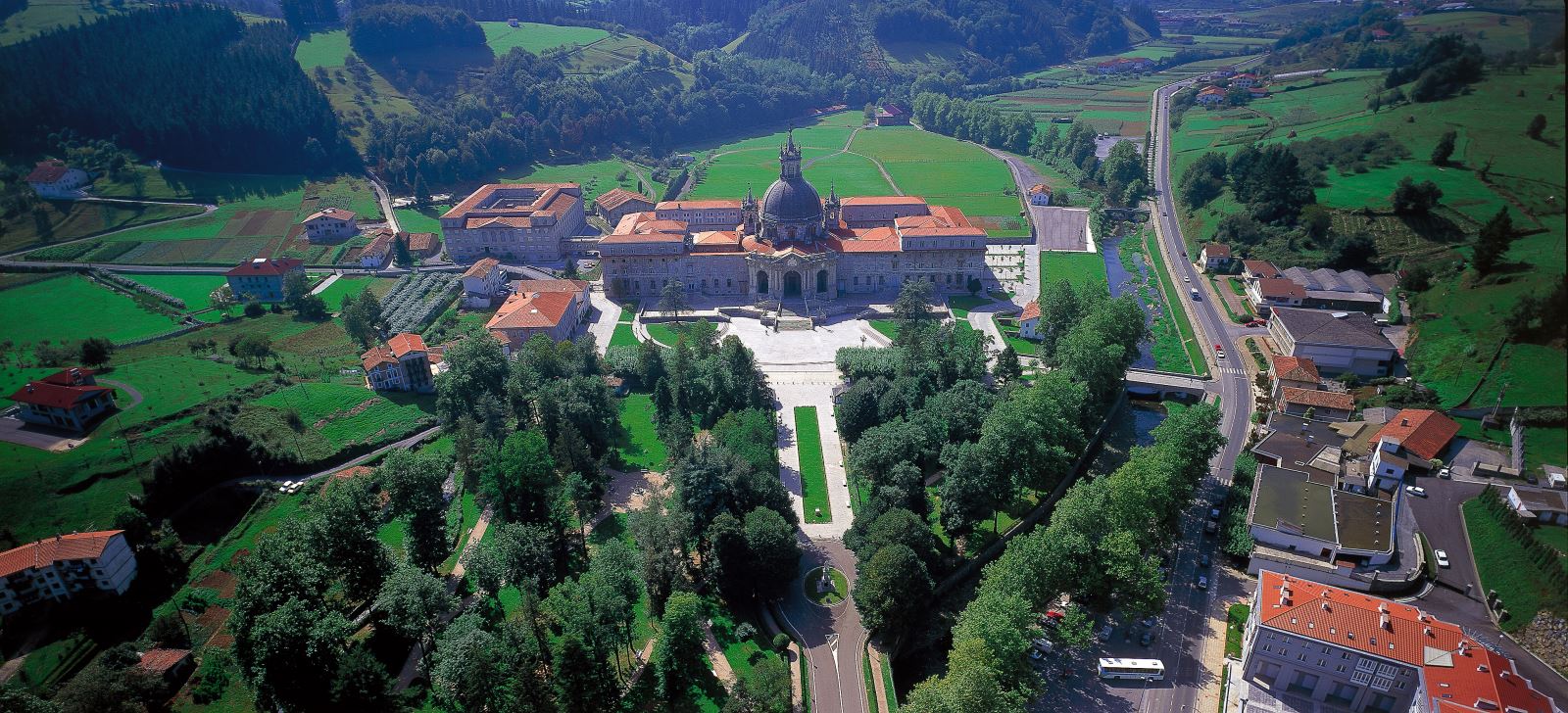
At Loyola station, the asphalt lane is interrupted by an unpassable railway tunnel that prevents us from following the original railway line. This interruption is merely an invitation to go through the shaded gardens and stop in front of the Sanctuary of Loyola, a masterpiece of Basque religious art. Under the aura of St. Ignatius, founder of the Company of Jesus, the sanctuary is a complex made up of a baroque basilica featuring a masterly dome and Churrigueresque façade, the Loyola family’s old tower house, where St. Ignatius was born in 1491, the Residence (1713), the former convent and other buildings of interest. This is the start point of the Ignatian Way, whose first section, as far as the locality of Zumarraga, coincides with the greenway’s route.
After passing the sanctuary, the greenway leaves behind the hustle and bustle of buses filled with tourists. Once again converted into a flat, lively walk, we enjoy a delightful section as the greenway passes through the wide, green Urola Valley: firstly, alongside the river, shaded by plane, ash, and alder trees; then, surrounded by green meadows and picturesque hamlets; and finally, terraced once again above the river.
On arrival at Azkoitia (km 23.8), the first half of the journey through its urban area is done on the bidegorri or bike lane that faithfully follows the route of the old railway, passing through the old Azkoitia station, now rehabilitated as library. In this town, the adoptive town of Oteiza, we can see the set of six pediments that symbolize the seven Historical Territories of Euskal Herria.
On the way out of Azkoitia, the unrecovered railway line —waiting for the future refurbishment of this section— requires strolling through a historic center declared a monumental complex. From the Azkoitia station, Xabier Munibe street leads to the channeled Urola river and to the Desusen Biohotz Agurgarria square, a social epicenter presided over by the parish of Santa María la Real and the blackened palace of the Idiakez. Generous cradle of mythical pelotaris, Azkoitia also follows the common pattern in the Urola valley: industries, farmhouses and history. Also noteworthy are the Balda tower-house, the Floreaga Zar palace and the Intsausti palace.
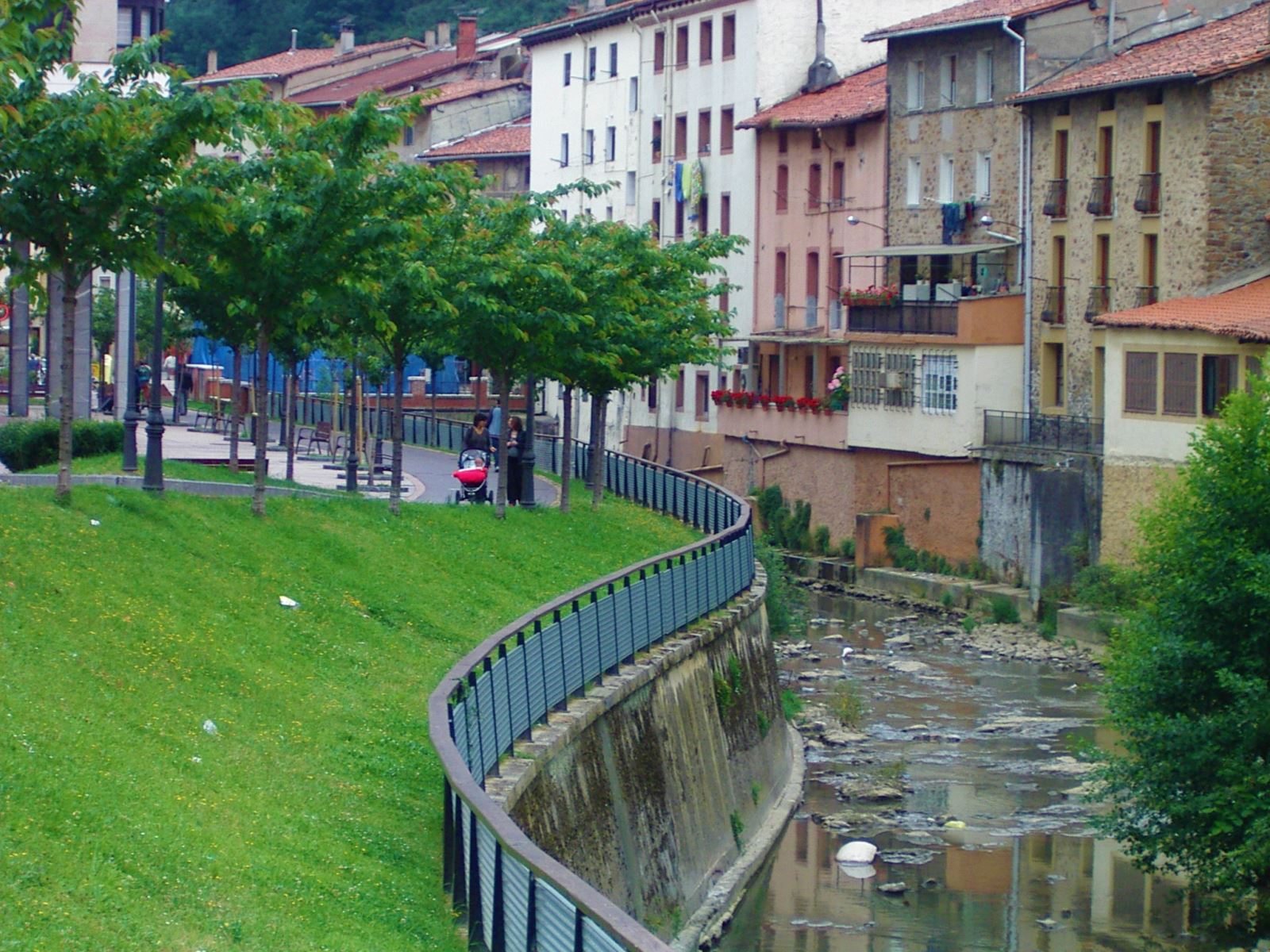 Without leaving the right bank, we will follow the Urola River upstream to a wide esplanade from where the railway line has been refurbished. The greenway borders the Jausoro neighbourhood, and ends at the Umansoro Diego Aita industrial estate. There, the left street leads to the car park at the back of the estate and the continuation of the greenway. Without leaving the right bank, we will follow the Urola River upstream to a wide esplanade from where the railway line has been refurbished. The greenway borders the Jausoro neighbourhood, and ends at the Umansoro Diego Aita industrial estate. There, the left street leads to the car park at the back of the estate and the continuation of the greenway.
This advances with personality between rows of young trees, outlines the industrial estate leaving large warehouses on one side, and on the other side high mountains of pine trees with leafy margins. Once past the polygon, the asphalt turns into compacted gravel and the road, without losing its straightness, plunges between fruit trees, orchards and scattered farmhouses and huts. Intermediate between urbanity and nature, this will be a placid stretch where a neighbor will be busy with the farming. Here we will also have the opportunity to pass under the only underpass on the entire route, a railway element that is a silent witness to the passage of so many trains.
Everything changes when crossing for the first time, on the same bridge, the river Urola and the GI 631 road. The road enters a narrow valley, which could be called a gorge, through which the road and the river run together. Crossing that first bridge means entering a wild world, where railway engineers had to work hard to make a strip of hillsides very difficult to master passable.
 And so, we proceed: trapped between tight and steep slopes covered entirely with ash, oak, alder, chestnut, maple, hazel, acacia, plane trees and a perennial pine forest that stretches towards the high peaks. From the aesthetic viaduct over four arcades, the wriggling of the river and valley is already a frank twist. For this reason, the road dispenses with the river and its basin as a natural route and, unlike the road, goes direct, drilling the rock with tunnels and building bridges over the river. Thus, the road turns its course into a continuous succession of aerial and underground walks. “Aerial” due to the colorful viaducts and numerous bridges that cross the road and the river, and of which we only see their simple railings or aesthetic curved parapets with resounding interlocking beams in the purest railway style. And "underground" walks through the many tunnels of all kinds: short, medium and long, curved or straight, lined with live rock or something of both, dry or wet, but always cool, with concrete floors and lighting. An eastern section that remains in the retinas and leaves one with the sensation that the railway here bent an intense orography. And so, we proceed: trapped between tight and steep slopes covered entirely with ash, oak, alder, chestnut, maple, hazel, acacia, plane trees and a perennial pine forest that stretches towards the high peaks. From the aesthetic viaduct over four arcades, the wriggling of the river and valley is already a frank twist. For this reason, the road dispenses with the river and its basin as a natural route and, unlike the road, goes direct, drilling the rock with tunnels and building bridges over the river. Thus, the road turns its course into a continuous succession of aerial and underground walks. “Aerial” due to the colorful viaducts and numerous bridges that cross the road and the river, and of which we only see their simple railings or aesthetic curved parapets with resounding interlocking beams in the purest railway style. And "underground" walks through the many tunnels of all kinds: short, medium and long, curved or straight, lined with live rock or something of both, dry or wet, but always cool, with concrete floors and lighting. An eastern section that remains in the retinas and leaves one with the sensation that the railway here bent an intense orography.
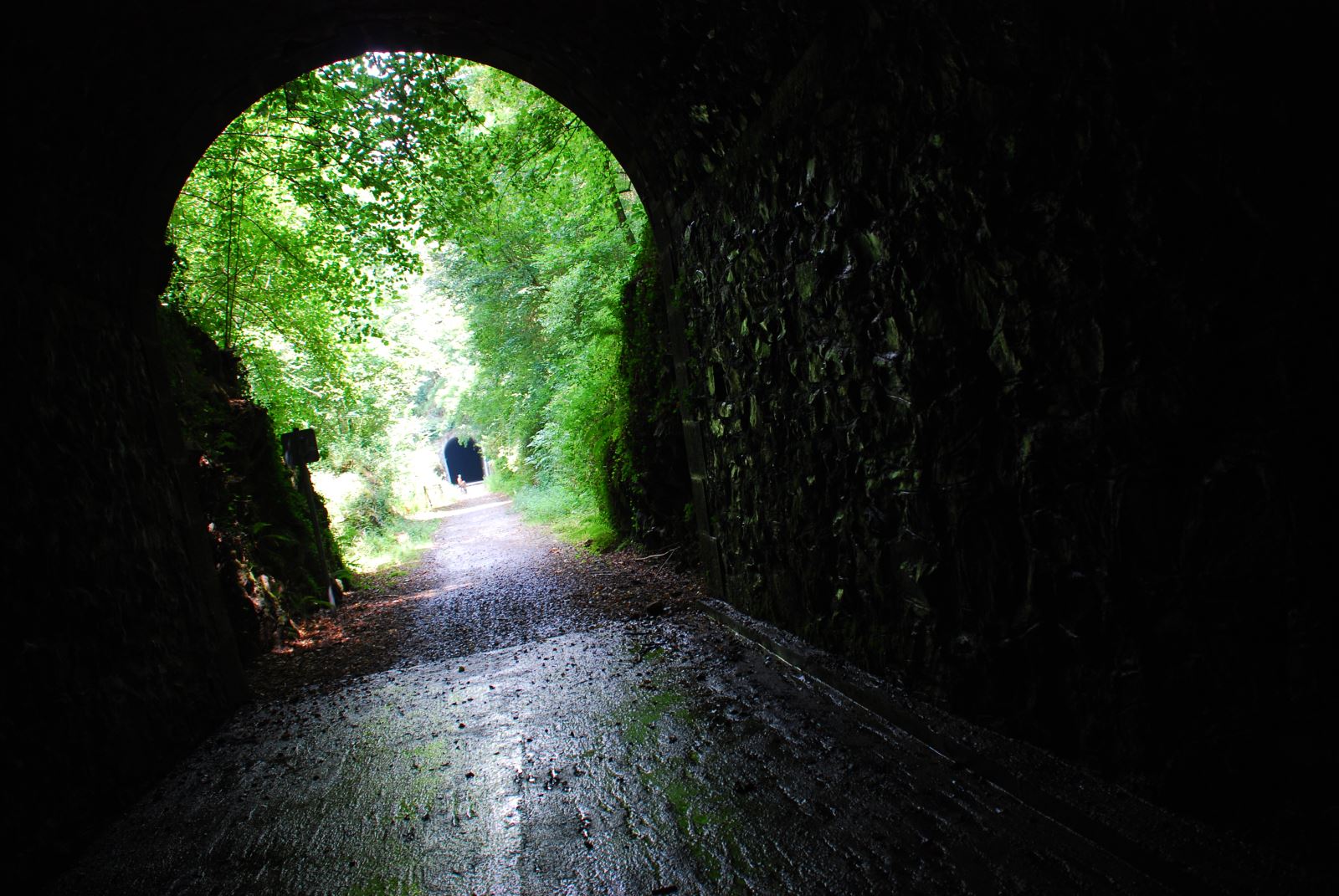 We will cross up to 9 bridges and 9 tunnels to reach the old Aizpurutxo station, a ghostly apparition among so much green. Immediately afterwards, the road crosses another bridge, enters tunnel 10 and terraces on the hillside, quite high, above the image of the town of Aizpurutxo (km 30.8). This small urban center has several bars that are highly frequented by users of the greenway. There is a path that goes down from the road, but there is also a fountain on the edge of the path in case we do not need provisioning. And down in the river, if we look closely we can easily see the crabs that inhabit these waters. We will cross up to 9 bridges and 9 tunnels to reach the old Aizpurutxo station, a ghostly apparition among so much green. Immediately afterwards, the road crosses another bridge, enters tunnel 10 and terraces on the hillside, quite high, above the image of the town of Aizpurutxo (km 30.8). This small urban center has several bars that are highly frequented by users of the greenway. There is a path that goes down from the road, but there is also a fountain on the edge of the path in case we do not need provisioning. And down in the river, if we look closely we can easily see the crabs that inhabit these waters.
From Aizpurutxo we continue through the Urola gorge, although now the leafy trees are limited to the river bed, giving free rein to a pine forest that copiously covers everything. Also, behind is the constant passing from one shore to another. From now on, the slope on the left will be our host; and the tunnels, almost consecutive before, will be spaced out as their length, curvature and darkness increase. Thus, the route loses the straightness that it displayed when entering the Urola valley, to adjust to the swaying of the slopes that rise towards the Irino and Zamiño mountains.
The greenway crosses the long tunnel 19, the last one on the route, and reaches the rest area in the area known as Mesa de Aginaga, on the side of the road that goes up to the homonymous village. The road leaves behind the narrow mountains, the tunnels and the bridges, to enter a valley where the mountains reduce their bravery and offer space to compose an idyllic image of meadows and farmhouses.
The Urola Greenway crosses the river and finally enters Urretxu and Zumarraga (km 32.8). Between buildings, the paved lane reaches the old station and the city center, where we can see its museum of minerals and fossils. After rubbing shoulders with terraces and gardens, the greenway continues like a pleasant riverside walk that ends at the old Zumarraga station, a beautiful example of popular architecture that imitates the forms of the Basque farmhouse.
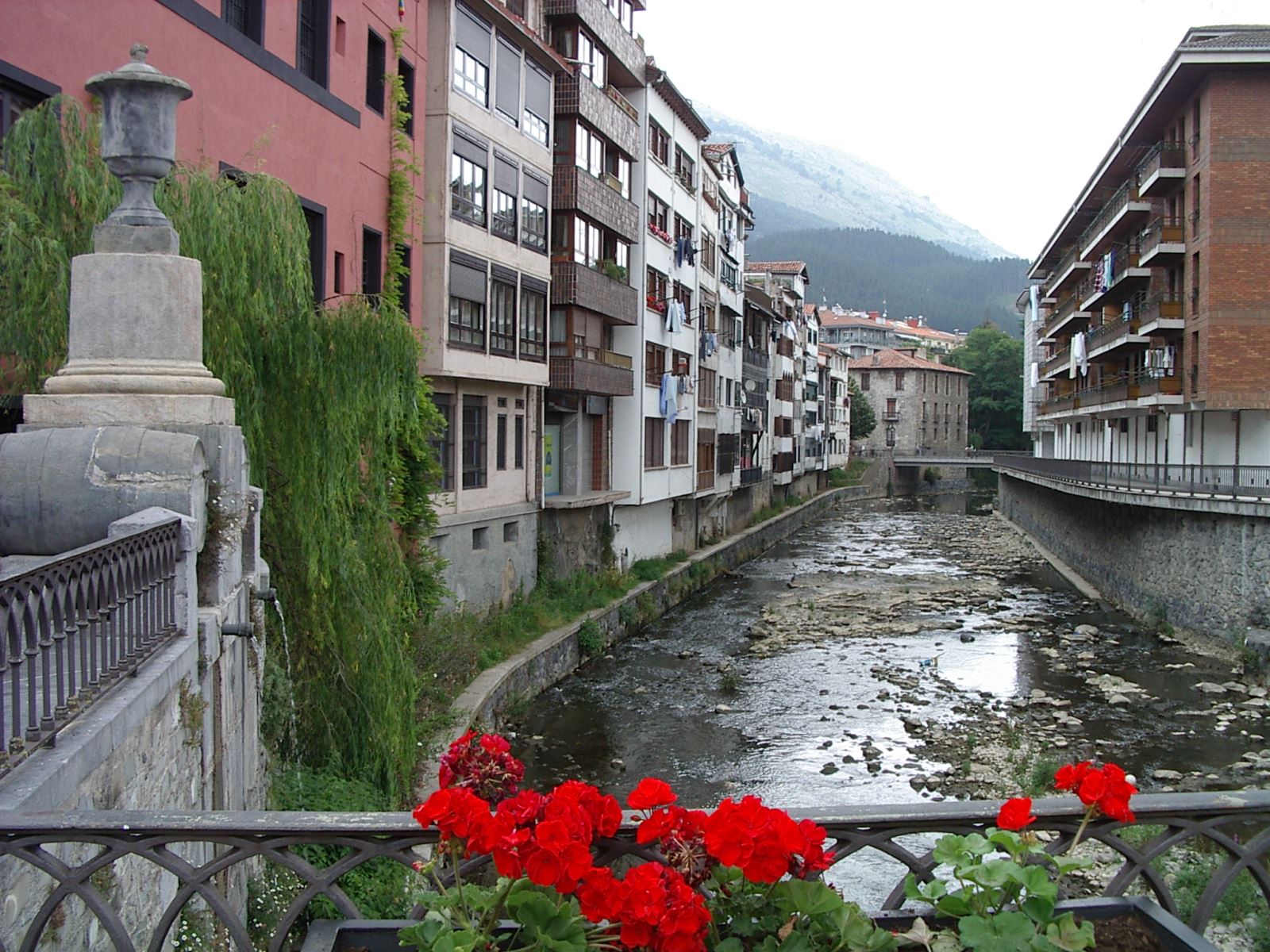 In Zumarraga, it is worth going off the beaten path to visit the hermitage of La Antigua, a unique national historical-artistic monument for its roof and truss made entirely of oak. Of course, you have to know that it is far away and on a hill. In Zumarraga, it is worth going off the beaten path to visit the hermitage of La Antigua, a unique national historical-artistic monument for its roof and truss made entirely of oak. Of course, you have to know that it is far away and on a hill.
In Zumarraga the old Urola railway ended its journey. However, the greenway that we have in hand extends, parallel to the active railway line, on the route used by Patricio Echevarría's merancías train, a key figure in Gipuzkoa's iron and steel industry.
Once again on the move, we go around the old station and ertzaintza post on the left side, to take the bidegorri painted red on the pavement, leaving the Zumarraga commuter line station on the left. Here, we can take the train and return to Donostia or continue on this bike path that continues along the median until reaching a roundabout. In front of the latter, the paved lane crosses the street on the left and embarks on a new voyage.
The greenway advances outlined on both sides by long metallurgical warehouses, smoking colossi and the smell of iron. We pass through an industrial zone so we will have to be attentive to the traffic of trucks. However, when crossing the Urola river, an open space is created where we can get some fresh air again before submerging ourselves again between industrial warehouses and the embankment that supports the passage of trains.
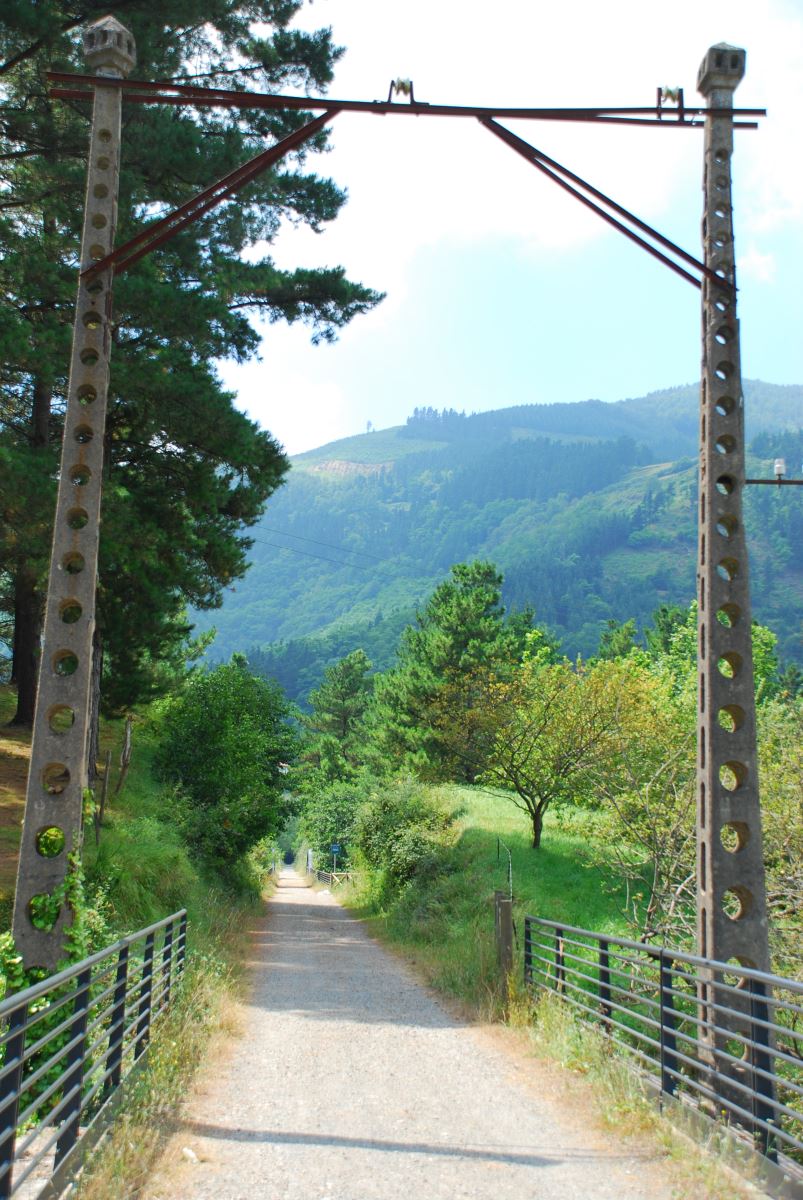 We reach Legazpi (km 42.3), the penultimate point of our route, in an industrial landscape that has its roots in those wind forges that, around the 13th century, began to take advantage of the vitality of the waters that came down from the mountains to settle on the banks of the Legazpi River, known since then as Urola, which in Basque means "forge water". In Legazpi it is essential to visit the Chillida Museum. On the lower floor is the artist's small workshop, as well as the forging machines with which he made many of his great sculptures, such as the Donostia Wind Comb. We reach Legazpi (km 42.3), the penultimate point of our route, in an industrial landscape that has its roots in those wind forges that, around the 13th century, began to take advantage of the vitality of the waters that came down from the mountains to settle on the banks of the Legazpi River, known since then as Urola, which in Basque means "forge water". In Legazpi it is essential to visit the Chillida Museum. On the lower floor is the artist's small workshop, as well as the forging machines with which he made many of his great sculptures, such as the Donostia Wind Comb.
The craft industries in this town have their own name and brand: Patricio Echevarria and Bellota. In 1908, Patricio opened a workshop dedicated to the production of tools for all trades, whose growth was so exponential that it was the engine of industrial and urban development in Legazpi in the 20th century. The visitor will be able to get a clear idea of this statement by going through a cultural route of more than 15 places linked to industrialization.
We still have the last 2 km of the route to Mirandaola (km 44.3), without a doubt, a place with much to offer. Legazpi also watches over its most ancient roots, being able to witness the artisans at the Mirandaola forge, a 16th-century hydraulic forge where you can see all the machinery and its operation, as well as the life of the ironworkers and the way of working the iron during the last century. Next to the forge, you can visit the Basque Iron Museum, which offers a sizzling show, a luxurious finale for this excellent greenway.
|
